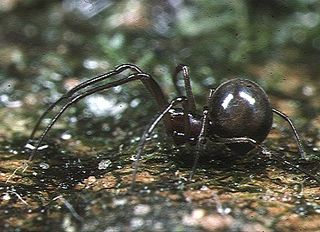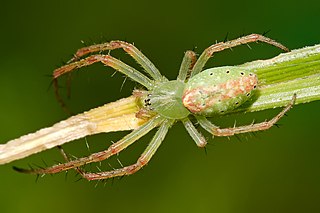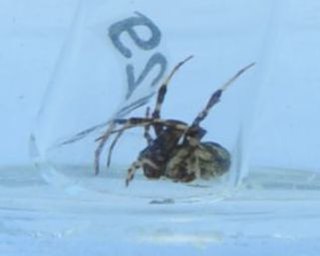
Huntsman spiders, members of the family Sparassidae, catch their prey by hunting rather than in webs. They are also called giant crab spiders because of their size and appearance. Larger species sometimes are referred to as wood spiders, because of their preference for woody places. In southern Africa the genus Palystes are known as rain spiders or lizard-eating spiders. Commonly, they are confused with baboon spiders from the Mygalomorphae infraorder, which are not closely related.

Selenopidae, also called wall crab spiders, wall spiders and flatties, is a family of nocturnal, free-ranging, araneomorph spiders first described by Eugène Simon in 1897. It contains over 281 species in nine genera, of which Selenops is the most well-known. This family is just one of several families whose English name includes the phrase "crab spider". These spiders are often called "Flatties" due to their flattened dorsal profile. The Afrikaans name for these spiders is "Muurspinnekop," which translates directly to "wall spider." The name Selenopidae comes from the greek moon goddess, Selene, as their eyes resemble the moon.

Missulena is a genus of mygalomorph spiders in the family Actinopodidae. It was first described by Charles Walckenaer in 1805, and is a senior synonym of Eriodon. M. tussulena is found in Chile, but the rest are indigenous to Australia. They are sometimes referred to as "mouse spiders" from the now-disproven belief that they dig deep burrows similar to those of mice. Scotophaeus blackwalli is also called a "mouse spider", but it is smaller and not closely related.

Cosmophasis is a genus of spiders in the family Salticidae. They are predominantly Southeast Asian, while some species occur in Africa and Australia. Although most species more or less mimic ants, there are also colorful species that follow a different strategy.

Nicodamidae is a family of araneomorph spiders with twenty-seven species in seven genera. They are small to medium-sized spiders found near the ground of eucalypt forest in small sheet webs. The species of this family are only present in Australia and Papua New Guinea. In most cases the cephalothorax and legs are uniformly red and the abdomen black, for which these species are sometimes called the "red and black spiders".

Stiphidiidae, also called sheetweb spiders, is a family of araneomorph spiders first described in 1917. Most species are medium size and speckled brown with long legs. All members of this family occur in New Zealand and Australia except for Asmea. They build a horizontal sheet-like web under rocks, hence the name "sheetweb spiders".

Anapidae is a family of rather small spiders with 232 described extant species in 58 genera. It includes the former family Micropholcommatidae as the subfamily Micropholcommatinae, and the former family Holarchaeidae. Most species are less than 2 millimetres (0.079 in) long.

Cyrtophora, the tent-web spiders, is a genus of orb-weaver spiders first described by Eugène Simon in 1895. Although they are in the "orb weaver" family, they do not build orb webs. Their tent-like, highly complex non-sticky web is sometimes considered a precursor of the simplified orb web. These webs are aligned horizontally, with a network of supporting threads above them. These spiders often live in colonies. Females have a body length of mostly about 10 millimetres (0.39 in) long. Some members, including Cyrtophora cicatrosa, exhibit the ability to change colour rapidly.

Arkys, also known as triangular spider or ambush spider, is a genus of Australian araneomorph spiders in the family Arkyidae, first described by Charles Athanase Walckenaer in 1837. They are often small, with a triangular shaped abdomen, and are found in Australia and some of its surrounding islands. They don't build webs, but can often be found on leaves and tips of flower heads. Their egg sacs are pinkish-orange and spherical, and are made late in the summer.
Novodamus is a genus of Australian cribellate spiders first described by Mark Stephen Harvey in 1995. As of November 2024 it contains only two species.
Prethopalpus is a spider genus known as goblin spiders and are found in the Australasian tropics, including Nepal, India, Indonesia, Papua New Guinea and Australia. Three species are widely distributed, whereas the majority of species are recorded a single localities. Of the 41 species, 14 blind troglobite species live in subterranean ecosystems in Western Australia.

Arkyidae, also known as triangular spiders, is a family of araneomorph spiders first described by Ludwig Carl Christian Koch in 1872 as a subfamily of Araneidae, and later elevated to a full family in 2017.
Ambicodamus is a genus of spiders in the family Nicodamidae. It was first described in 1995 by Mark Harvey. As of 2017, it contains 11 species, all from Australia.
Durodamus is a monotypic genus of spiders in the family Nicodamidae. It was first described in 1995. As of 2024, it contains only one species, Durodamus yeni, found in Queensland, Victoria, and South Australia.
Litodamus is a genus of spiders in the family Nicodamidae. It was first described in 1995 by Mark Harvey. As of 2024, it contains 3 species, all from Tasmania.
Oncodamus is a genus of spiders in the family Nicodamidae. It was first described in 1995 by Mark Harvey. As of 2024, it contains 2 Australian species.
Yoroa is a genus of South Pacific comb-footed spiders that was first described by L. Baert in 1984. As of June 2020 it contains two species, found in Australia and Papua New Guinea: Y. clypeoglandularis and Y. taylori.

Gea eff is a species of orb-weaver spider. It is found in Papua New Guinea. The arachnologist Herbert Walter Levi formally described the species in 1983. While it was still undescribed, Michael H. Robinson and colleagues reported on its courtship and mating behaviors. Gea eff has the shortest scientific name of any spider species.











